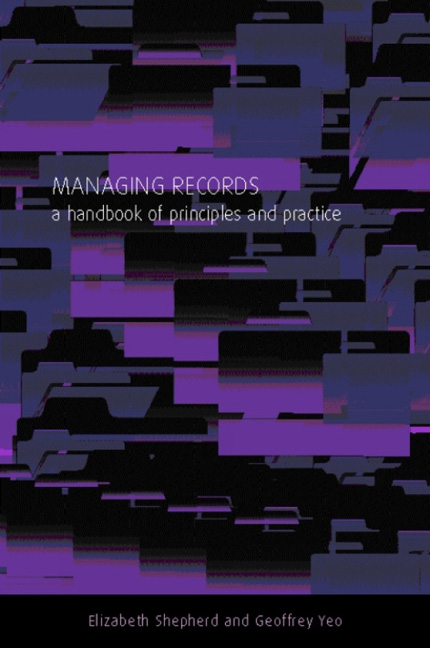Book contents
- Frontmatter
- Contents
- Preface
- Editorial note
- Introduction
- 1 Understanding records management
- 2 Analysing the context for records management
- 3 Classifying records and documenting their context
- 4 Creating and capturing records
- 5 Managing appraisal, retention and disposition
- 6 Maintaining records and assuring their integrity
- 7 Providing access
- 8 Implementing records management: practical and managerial issues
- Conclusion
- Appendix A Bibliography and sources of further information
- Appendix B Select list of national and international standards
- Appendix C Professional organizations for records managers in English-speaking countries
- Index
5 - Managing appraisal, retention and disposition
Published online by Cambridge University Press: 09 June 2018
- Frontmatter
- Contents
- Preface
- Editorial note
- Introduction
- 1 Understanding records management
- 2 Analysing the context for records management
- 3 Classifying records and documenting their context
- 4 Creating and capturing records
- 5 Managing appraisal, retention and disposition
- 6 Maintaining records and assuring their integrity
- 7 Providing access
- 8 Implementing records management: practical and managerial issues
- Conclusion
- Appendix A Bibliography and sources of further information
- Appendix B Select list of national and international standards
- Appendix C Professional organizations for records managers in English-speaking countries
- Index
Summary
In records management, appraisal is the process by which an organization identifies its requirements for maintaining records.
Records managers have developed appraisal techniques primarily to support decisions about retention: which records can be destroyed at an early stage, and which merit longer-term or indefinite retention? However, appraisal can also be used to support other decisions. According to the Australian records management standard, appraisal seeks ‘to determine which records need to be captured’ into a records management system as well as ‘how long the records need to be kept’ (AS 4390.1-1996, clause 8.1). Other uses might include decisions on what records should be created, or identifying those that require special measures for protection or security. In a comprehensive records management programme a range of appraisal decisions may be required.
This chapter examines different theories of appraisal and considers how appraisal techniques can be applied to control the retention of records. Effective retention management demands a system which ensures that records are retained for as long as necessary and that those no longer required are eliminated. This chapter discusses three components of the system: methodologies for making appraisal decisions; documentation of decisions; and operational measures for their implementation.
The need for retention controls
Records, whether paper or digital, cannot all be retained indefinitely. Storage and maintenance over time is often expensive and, as the volume of records grows, access becomes slower and more difficult.
In practice some kind of appraisal occurs even where no records management programme exists. In the absence of formal controls, retention decisions are made on local initiative. Usually nothing is done until cabinets or servers are full, then someone makes a decision on what to do about it: paper records are moved to another storage area, a bigger server is acquired, or records are moved offline or destroyed. Such decisions are often arbitrary: redundant records are kept, thus incurring unnecessary expense, or records still needed are destroyed prematurely.
A records management programme aims to ensure that retention decisions are made rationally. One of its key justifications is protection of the organization against legal action. Besides retention of records needed for legal defence, this includes the ability to show why any particular records were destroyed.
- Type
- Chapter
- Information
- Managing Recordsa handbook of principles and practice, pp. 146 - 172Publisher: FacetPrint publication year: 2003



